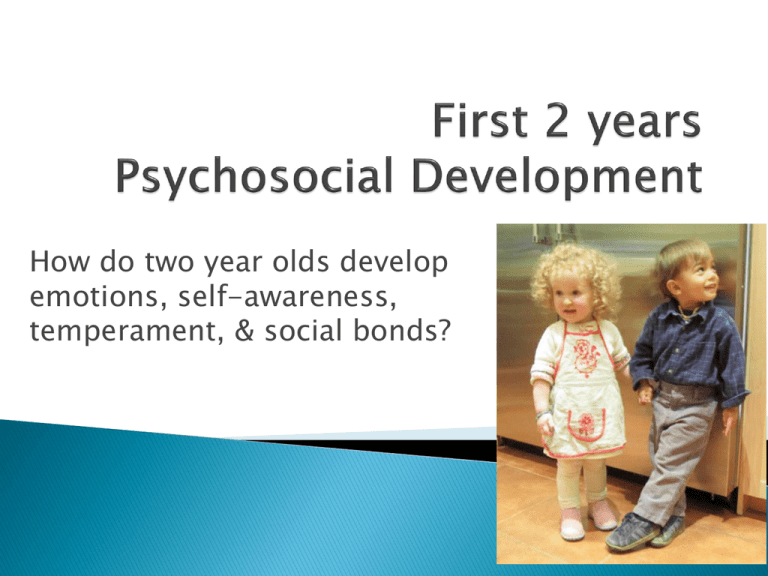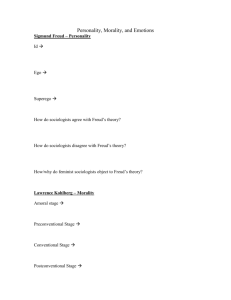How do two year olds develop emotions, self-awareness, temperament, & social bonds?
advertisement

How do two year olds develop emotions, self-awareness, temperament, & social bonds? Newborns = two emotions ◦ Distress & contentment Happiness = Social smile ◦ Occurs when seeing a face Anger = frustration Sadness = withdrawal & stress Social fear ◦ Stranger wariness ◦ Separation anxiety These changes gradually develop during the first year. I am separate from others Mirror rouge test Me & mine Generally develops during the second year Emotions become more sophisticated as the cortex and memory develops Stress can effect the parts of the brain related to emotions ◦ Hypothalamus ◦ Amygdala Temperament = Genetic predispositions ◦ Shyness & aggression ◦ Whether these are expressed is based on experience – culture, childrearing methods, etc. ◦ Harsh parenting combined with a negative temperament can create antisocial, destructive children. Personality traits = Learned ◦ Honesty and humility Adults who are extroverts, agreeable, and positive = warmer, more competent parents. What emotions develop over the first year? How can you tell when a child develops self-awareness? What causes emotions to become more complex? What parts of the brain are related to emotions? What type of parenting creates antisocial, destructive children? Psychoanalytic ◦ Freud ◦ Erikson Behaviorism Cognitive Sociocultural Freud Oral stage (1st. Yr.) ◦ E.g. Breast-feeding ◦ Oral fixation E.g. Fingernail biting, smoking, overeating Anal (2nd. Yr.) ◦ Bowels ◦ Self-controlled Anal personality ◦ Most people disagree with this idea ◦ Toilet training – Later age = less time Trust vs. mistrust Autonomy (independence & self-rule) vs. shame and doubt Emotions & personality ◦ Based on reinforcement & punishment by parents Social learning ◦ Albert Bandura ◦ Bobo doll experiment ◦ Children express emotions they see others do During what period of Freud’s Psychoanalytic theory does toilet training occur? If a child toilet trains later, will it take longer to accomplish? What question must a child resolve in Erikson’s first stage? What do the behaviorists assume creates a personality? What does social learning theory assume creates emotions? Working models ◦ A set of assumptions that children use as a frame of reference ◦ People are warm & friendly ◦ People can never be trusted Interpretation of experiences is most crucial Culture is most important Proximal (close) parenting ◦ Much body contact ◦ Children become More compliant Less independent More separation & stranger anxiety Distal (far) parenting ◦ Less body contact ◦ Children become Less obedient More independent Less separation & stranger anxiety Attachment ◦ Proximity-seeking Following caregivers ◦ Contact maintaining Touching, snuggling, holding Social referencing ◦ Toddlers referring to parental emotions & actions to evaluate a situation E.g. eating new foods Crossing the street Give an example of a working model a child might develop? What is the difference between proximal and distal parenting? ◦ Which method would you use, and why? ◦ Give an example of social referencing a child might use?





